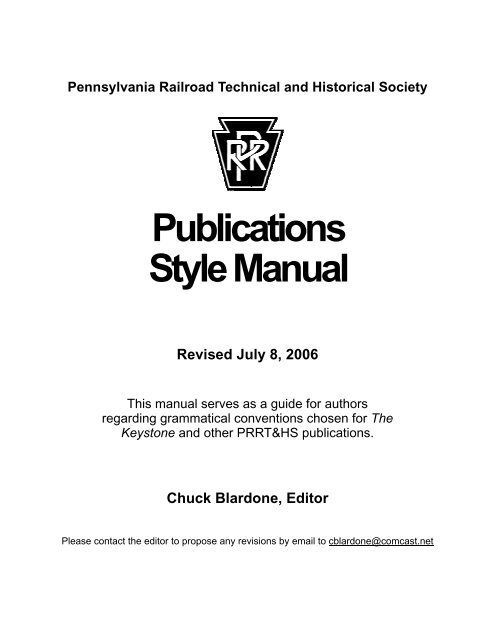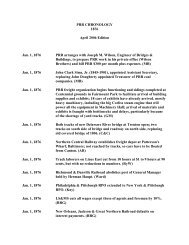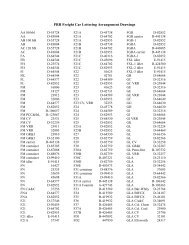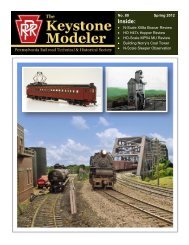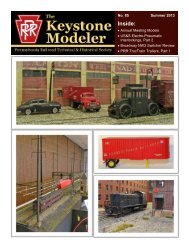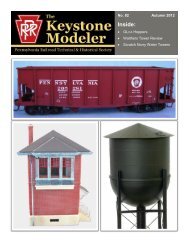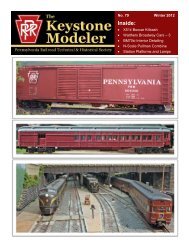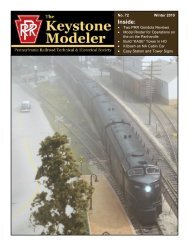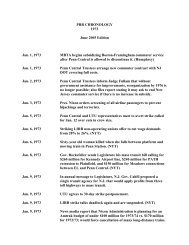Keystone Style Manual - Pennsylvania Railroad Technical and ...
Keystone Style Manual - Pennsylvania Railroad Technical and ...
Keystone Style Manual - Pennsylvania Railroad Technical and ...
You also want an ePaper? Increase the reach of your titles
YUMPU automatically turns print PDFs into web optimized ePapers that Google loves.
<strong>Pennsylvania</strong> <strong>Railroad</strong> <strong>Technical</strong> <strong>and</strong> Historical Society<br />
Publications<br />
<strong>Style</strong> <strong>Manual</strong><br />
Revised July 8, 2006<br />
This manual serves as a guide for authors<br />
regarding grammatical conventions chosen for The<br />
<strong>Keystone</strong> <strong>and</strong> other PRRT&HS publications.<br />
Chuck Blardone, Editor<br />
Please contact the editor to propose any revisions by email to cblardone@comcast.net
Table of Contents<br />
Table of Contents............................................................................................................ 2<br />
Names of Companies <strong>and</strong> Organizations........................................................................ 3<br />
Names of Various Parts of the <strong>Railroad</strong> .......................................................................... 3<br />
Names <strong>and</strong> Numbers of Trains <strong>and</strong> Cars ........................................................................ 3<br />
Names of Services; Other Names................................................................................... 4<br />
Locomotives – General ................................................................................................... 4<br />
Locomotive Classes – General ....................................................................................... 5<br />
Locomotive Classes – Details ......................................................................................... 5<br />
Locomotive Classes – Comments on specific classes .................................................... 6<br />
Locomotives – Other ....................................................................................................... 6<br />
Cars................................................................................................................................. 6<br />
Maintenance-of-Way Equipment ..................................................................................... 7<br />
Other <strong>Railroad</strong> Stuff......................................................................................................... 8<br />
Directions, Regions of the Country, Places ..................................................................... 8<br />
Time ................................................................................................................................ 8<br />
People, Job Titles, Etc..................................................................................................... 9<br />
Numbers.......................................................................................................................... 9<br />
Units of Measurement- Abbreviations <strong>and</strong> Symbols........................................................ 9<br />
Measurements .............................................................................................................. 10<br />
<strong>Railroad</strong> Abbreviations .................................................................................................. 10<br />
Preferred spellings ........................................................................................................ 10<br />
Special Rules for Charts................................................................................................ 11<br />
Miscellaneous ............................................................................................................... 12<br />
General Writing <strong>Style</strong> .................................................................................................... 12<br />
References.................................................................................................................... 13<br />
PRRT&HS Publications <strong>Style</strong> <strong>Manual</strong> page 2
Names of Companies <strong>and</strong> Organizations<br />
1. Use: the <strong>Pennsylvania</strong> <strong>Railroad</strong> (but The Pullman Company)<br />
2. <strong>Railroad</strong> name abbreviations shall be all capitals, close-coupled, without periods.<br />
Use an ampers<strong>and</strong> or hyphen where appropriate. Examples: PRR, P-RSL, NYC,<br />
EL, ACL, DL&W, CMSt.P&P<br />
3. <strong>Railroad</strong> names shall contain ampers<strong>and</strong>s instead of the word “<strong>and</strong>,” as in Denver<br />
& Rio Gr<strong>and</strong>e Western, not Denver <strong>and</strong> Rio Gr<strong>and</strong>e Western<br />
4. Pennsy is a nickname <strong>and</strong> would normally be enclosed in quotations, except for<br />
the fact that the PRR did not use quotations<br />
5. Builders: American Car & Foundry, ACF, Budd, Pullman, Pullman-St<strong>and</strong>ard, PS,<br />
American Locomotive Company, ALCo, Baldwin Locomotive Works, BLW<br />
6. Organizations: similar rules apply as to railroads: USRA, ICC, FRA, AAR,<br />
PRRT&HS<br />
Names of Various Parts of the <strong>Railroad</strong><br />
1. Renovo Division, Buckeye Region, Chestnut Hill Branch<br />
2. The Philadelphia-to-Pittsburgh (original) line is the Main Line. All other trackage is<br />
the main line<br />
3. Track 1; No.1 Track<br />
4. Kobuta Industrial Track, #1 Storage Track, Georgetown Secondary Track, Cadiz<br />
Secondary.<br />
5. Refer to routes as the “Water Level Route” <strong>and</strong> the “Golden State Route.” Also the<br />
“Overl<strong>and</strong> Route,” but <strong>Pennsylvania</strong>’s route<br />
6. Pennsy’s Altoona Shops, Pullman’s Calumet Shops<br />
7. “PG” tower; “PG” block <strong>and</strong> interlocking station; “PG” block-limit station; Houston<br />
tower.<br />
8. A 22-stall roundhouse, a 25-track classification yard; but: Sunnyside yards, Ivy City<br />
yards, 30th Street yards<br />
Names <strong>and</strong> Numbers of Trains <strong>and</strong> Cars<br />
1. Train numbers: Train #66, Train #49, Train #221.<br />
2. Spell out Train, as in Train #59 (do not abbreviate).<br />
PRRT&HS Publications <strong>Style</strong> <strong>Manual</strong> page 3
3. Train names: the Philadelphia “Clockers” or the “Clockers.” The NYC's premier<br />
train was the 20th Century Limited or the Century.<br />
4. Broadway Limited, The American, “Spirit of St. Louis,” as the timetable of the<br />
relevant period shows. (Train names sometimes varied from year to year;<br />
sometimes a “the” was included, other times not.) Note that the “Spirit of St. Louis”<br />
is a special case, having quotation marks <strong>and</strong> being italicized.<br />
5. Wheeling-to-Pittsburgh train, New York-Wheeling sleeping car line.<br />
6. Names of specific cars (<strong>and</strong> boats) shall be in italics: Andrew Carnegie, Herald<br />
Square, Octagon House, Mask And Wig Club, Cheriton, Chicago II (second tug of<br />
that name).<br />
7. Names of classes of cars shall be in lower case: parlor cars, diners.<br />
8. Names of cars owned by companies thus: Pullman cars.<br />
9. Class names shall likewise be italicized: Imperials, the Pennsy Clubs, the PRR<br />
Creeks.<br />
Names of Services; Other Names<br />
1. New York-Wheeling sleeping car line.<br />
2. Army-Navy Special (but: Army-Navy game).<br />
3. Restaurant Car Service.<br />
4. Accommodations; not accommodation.<br />
5. Crockery: PRR “<strong>Keystone</strong>,” NYC “De Witt Clinton,” Pullman “Indian Tree.”<br />
6. The PRR publication is italicized (the Pennsy).<br />
Locomotives – General<br />
1. Steam locomotive, not steam engine (unless referring to one gear arrangement on<br />
a single steam locomotive).<br />
2. The PRR also called an electric locomotive a motor.<br />
3. An engine converts energy into mechanical motion; a motor converts electric<br />
current into mechanical power. Thus, stoker engine, not stoker motor.<br />
4. A locomotive is referred to as an “it.” It is sexless.<br />
5. Walschaert gear is correct; Walschaerts gear is not (unless it is used in the<br />
possessive case, with an apostrophe: Walschaerts’ design). His name was<br />
Walschaerts, but the design was patented under the name Walschaert for political<br />
reasons.<br />
PRRT&HS Publications <strong>Style</strong> <strong>Manual</strong> page 4
Locomotive Classes – General<br />
1. Do not use hyphens in locomotive (or tender or car) classes, e.g., K4S, not K-4S<br />
<strong>and</strong> EFS17ms, not EFS-17ms.<br />
2. No capital letter in “class,” <strong>and</strong> class always leads, not trails: class K4S; class GG1<br />
3. Locomotive (<strong>and</strong> car) subclasses shall be in 2/3-height capitals (small caps): class<br />
GSD, H21A, K4SA, 70P55A.<br />
4. The nickname of a locomotive class shall be capitalized: I1S Decapods, H9S<br />
Consolidation, but in the case of nicknames, it shall also be italicized, such as NYC<br />
Mohawk.<br />
5. Avoid using plurals for classes of locomotives <strong>and</strong> cars (which can confuse the true<br />
class), i.e., no P70s, H21s, K4S (as a plural). If necessary to have plurals,<br />
separate the class with an apostrophe <strong>and</strong> “s,” such as K4S’s, P70R’s<br />
6. If an abbreviated form of a locomotive’s class is written, such as “K4” (for K4S) or<br />
“G” (for GG1), the abbreviated form should be enclosed in quotations, as these<br />
classes never existed (i.e., “K4,” “G”).<br />
7. The PRR adopted reclassification of steam locomotives on various dates:<br />
• PRR Lines East 9/1/1897 (including subsidiary lines)<br />
• Southwest System 10/1/1897<br />
• Northwest System 1/1/1898<br />
When both classes of a locomotive are given, the former or latter should be in<br />
parenthesis, depending on the date in discussion or for a photo. In other words, a<br />
photo of a class D locomotive taken before the new classification should read<br />
D(G1). If the photo is after the new classification, it should read (D)G1.<br />
Locomotive Classes – Details<br />
1. Officially, locomotives without st<strong>and</strong>ard classes were known as “odd.” These can<br />
be designated H-odd or odd-H. Narrow-gauge “odd” locomotives could be H-<br />
odd(NG) or odd-H(NG).<br />
2. For very early power (including the PRR <strong>and</strong> subsidiary lines), before any form of<br />
classification was used, the wheel arrangement is appropriate. In the case of tank<br />
engines, a suffix is needed, such as 0-4-0T. The suffix “T” is generally construed<br />
to mean “saddletank,” but could also denote “sidetank.” A supplemental<br />
clarification is justified in this latter case, such as 0-4-0T*, with the * footnote noting<br />
the tank was mounted above the drivers rather than atop the boiler.<br />
3. Where a classification was used by the railroad a second time, a prefix is required.<br />
One example was class B29. This was used by the Northwest System for a<br />
couple of years, then abolished. Shortly afterward, class B29, an entirely new<br />
PRRT&HS Publications <strong>Style</strong> <strong>Manual</strong> page 5
design, appeared on the <strong>Pennsylvania</strong> Lines. This would be properly written as<br />
1/B29 <strong>and</strong> 2/B29, respectively.<br />
4. There are not many cases where abbreviations in parentheses are required in<br />
correctly distinguishing locomotive classes. Important ones are: (PV) piston<br />
valves, (NG) narrow-gauge, (SH) superheater, (RV) rotary valves, (HF) h<strong>and</strong>-fired,<br />
(B) booster, (U) underfeed stoker, (S) stoker (after 1924), (O) overfeed stoker,<br />
(SHU) superheater <strong>and</strong> underfeed stoker, (OF) oil-fired, (ST) saddle tank (if side<br />
tank, that should be spelled out), (MOD) modified, (MM) modified mallet.<br />
Distinctions in parenthesis can be upper or lower case. Often the stoker distinction<br />
is unneeded. All M1 had stokers when built, except for the first one, which was<br />
h<strong>and</strong>-fired <strong>and</strong> should be designated M1 (HF). All I1S had stokers as built,<br />
although a few were made h<strong>and</strong>-fired for hump service in the mid-1920s <strong>and</strong><br />
should be shown I1S(HF). While all N1S were built with stokers, those with the<br />
Crawford type should be noted N1S(U), the remainder simply N1S (the overfeed<br />
stoker being assumed).<br />
Locomotive Classes – Comments on specific classes<br />
1. If the designation K4S(s) is used, the proper interpretation is that this is a K4S with<br />
overfeed stoker (as opposed to h<strong>and</strong>-fired). Up until 1924, the use of (O) <strong>and</strong> (U)<br />
as a suffix of the locomotive class denotes overfeed or underfeed stokers,<br />
respectively.<br />
2. P5A motors, if steeple cabs (not box cabs) are P5A(mod).<br />
Locomotives – Other<br />
1. The term Brunswick green, was used by the PRR on some diesel-electric<br />
locomotive drawings, so it may be acceptable in such cases. Otherwise use dark<br />
green locomotive enamel.<br />
Cars<br />
1. There are stainless-steel cars <strong>and</strong> 10-roomette, 6-double bedroom Pullmans.<br />
2. Some cars are made of stainless steel <strong>and</strong> contain 10 roomettes <strong>and</strong> 6 double<br />
bedrooms.<br />
3. There are Tuscan-red cars; but some cars are Tuscan red.<br />
4. The Pennsy didn’t have cabooses; it had cabin cars.<br />
5. Pullman plan #s have capitalized suffixes: #3989A, #4019B, #3997A.<br />
6. Car accommodations (compound adjective): 7-drawing room car, 22-roomette car.<br />
But in a sentence: This car has seven drawing rooms, while this one contains 22<br />
PRRT&HS Publications <strong>Style</strong> <strong>Manual</strong> page 6
oomettes.<br />
Maintenance-of-Way Equipment<br />
Many people loosely applied the term “maintenance-of-way” to all equipment used in<br />
company service. Although the MW Department did have a lot of work equipment, it<br />
was not the only department that did. The PRR “work equipment” used in company<br />
service was in fact assigned to other departments that shared equal stature with the<br />
MW Department, to wit, the Material <strong>and</strong> Stores Department <strong>and</strong> the Mechanical<br />
Department. The following may be used as a general guideline:<br />
1. Most wreck derricks <strong>and</strong> wreck trains were assigned to the Mechanical<br />
Department, as they were used to right <strong>and</strong> re-rail equipment, <strong>and</strong> the mechanical<br />
folks were responsible for clearing wrecks. However, most cranes (locomotive,<br />
Burro <strong>and</strong> crawler) were assigned to the MW Department, as they were used to<br />
perform track maintenance work.<br />
2. Most camp cars (class XL <strong>and</strong> passenger) were assigned to the MW Department,<br />
as they were used to house the roving maintenance gangs. However, these same<br />
style cars used in wreck trains were assigned to the Mechanical Department. The<br />
camp cars in the MW Department were further assigned to Bridge & Building<br />
(B&B) gangs, Communication & Signal (C&S) gangs or track gangs. However,<br />
these further distributions are usually difficult to discern. Equipment used in wire<br />
trains <strong>and</strong> the motor cars converted to tower cars were assigned to the Electric<br />
Traction (ET) Department.<br />
3. Company service box cars (gray or yellow) were typically found in MW service, as<br />
tool <strong>and</strong> supply or material <strong>and</strong> supply cars. However, some gray cars were<br />
assigned to the material <strong>and</strong> stores folks. The freight car red box cars (“S cars”)<br />
were typically assigned to the Material & Stores department for the transport of<br />
supplies.<br />
4. Company service flat cars were typically assigned to the MW Department, except<br />
the wheel cars, which were in the Stores Department, transporting wheel sets for<br />
the mechanical guys. Gondolas were also mostly with the MW folks.<br />
5. Company service hoppers were typically assigned to the MW Department, for<br />
ballast service (although some were used to haul ashes).<br />
6. Flangers, snowplows <strong>and</strong> Jordan spreaders were in the MW Department.<br />
7. Tank cars used for the movement of new <strong>and</strong> used petroleum, oil <strong>and</strong> lubricants<br />
products <strong>and</strong> covered hoppers used for s<strong>and</strong> service were assigned to the Stores<br />
Department.<br />
8. Company service cabins were assigned to either the MW Department for work<br />
train use or the Mechanical Department for wreck train use.<br />
9. The poling cars were probably assigned to the Chief of Transportation, for use in<br />
yard shifting.<br />
PRRT&HS Publications <strong>Style</strong> <strong>Manual</strong> page 7
Other <strong>Railroad</strong> Stuff<br />
1. Employees Timetable No. 10; employees timetable (note no apostrophes).<br />
2. Spell “employees,” even though the PRR typically used the spelling “employes.”<br />
Directions, Regions of the Country, Places<br />
1. Regions of the country: the North, the South, the East, the West, the Midwest.<br />
Example: The Broadway Limited connected the East with the Midwest.<br />
2. Directions: north, south, east, west. Example: Train #29 went west <strong>and</strong> Train #28<br />
went east.<br />
3. Only a few major <strong>and</strong> well-known cities need not have states accompanying them:<br />
Philadelphia, New York, Chicago, Los Angeles, etc.<br />
4. Lesser-known places should have states abbreviated: Dillsburg, Pa., Springfield,<br />
Ill., Jacksonville, Fla. Washington, D.C. is always accompanied by D.C.<br />
5. If giving a mailing address (such as in a product review or advertisement), use post<br />
office convention: Lancaster, PA 17601.<br />
Time<br />
1. Numbered periods of time are generally in lowercase: twentieth century, nineteenth<br />
century; Named periods of time capitalized: the Great Depression.<br />
2. Note apostrophe usage: the mid-’50s, the 1960s, the roaring ’20s<br />
3. Seasons:<br />
a. Generally: spring, summer, autumn, winter. Do not use fall in place of<br />
autumn.<br />
b. When personified: Spring, Summer, Autumn, Winter. Example: Spring’s<br />
warm touch, Winter’s icy blast.<br />
4. Full dates should be presented in sequence: month, day, year.<br />
a. In text, write out: June 15, 1938;<br />
b. In text, in reference to a timetable, may be shortened: 6/15/1938.<br />
c. In a chart <strong>and</strong> caption: always use short form: 6/15/1938.<br />
5. If only the month <strong>and</strong> year are known:<br />
a. In text, spell out, without comma: September 1947, October 1956 <strong>and</strong><br />
February 1968. Do not abbreviate months.<br />
b. In headings, captions, charts, use numerals: 9/1947, 10/1956 <strong>and</strong> 2/1968.<br />
PRRT&HS Publications <strong>Style</strong> <strong>Manual</strong> page 8
6. There is no comma between the month <strong>and</strong> the year. Use a comma between<br />
season <strong>and</strong> year.<br />
7. Times may be presented either in the a.m./p.m., system (i.e., 3:08 a.m., 3 p.m.) or<br />
the 24-hour system (i.e. 0308 hours, 1500 hours).<br />
8. Time zones should be capitalized, with no periods: EDT, EST, CST.<br />
People, Job Titles, Etc.<br />
1. Use a person's full given name unless he/she is commonly known otherwise:<br />
Arthur D. Dubin, Robert J. Wayner, William W. Kratville, but Don Wood instead of<br />
Walter Don Wood.<br />
2. Engineman Cody, Superintendent Gratz, but the engineman of the train<br />
Numbers<br />
1. Numbers: one through ten shall be spelled out; 11 <strong>and</strong> above are numerals. Spell<br />
out the number when it starts a sentence.<br />
2. Use discretion <strong>and</strong> favor numbers as in a series: 17 for NYC, 9 for C&O, <strong>and</strong> 2 for<br />
PRR.<br />
3. 3,420; 15,200; 1,320,000 (commas for thous<strong>and</strong>s, millions).<br />
4. Always use the # sign preceding numbers: plan #3523C, car #7001, diagram #56.<br />
5. In immediate series, use the # sign once: PRR Train #s 30 <strong>and</strong> 31 were the top<br />
New York-to-St. Louis flyers. Use the # sign twice if the numbers referred to are<br />
more distantly related: PRR Trains #30 <strong>and</strong> #66 served St. Louis.<br />
Units of Measurement- Abbreviations <strong>and</strong> Symbols<br />
1. A.C. alternating current<br />
2. a.m. ante meridiem (before noon)<br />
3. amps amperes<br />
4. D.C. direct current<br />
5. hp horsepower<br />
6. Hz. Hertz<br />
7. kW kilowatt<br />
8. mph miles per hour<br />
9. p.m. post meridiem (after noon)<br />
10. V/kV volt(s)/kilovolt(s)<br />
11. ' feet<br />
12. " inches<br />
13. ø diameter<br />
14. ° degrees<br />
15. φ phase (power)<br />
16. # number<br />
PRRT&HS Publications <strong>Style</strong> <strong>Manual</strong> page 9
Measurements<br />
1. If writing about tenths of a mile: 0.4 mile; 0.25 mile, 0.5 mile.<br />
2. 0.5 mile may be written a “half mile;” 0.25 mile may be written “a quarter mile.”<br />
3. Feet <strong>and</strong> inches: Spell out if only feet or inches: four feet.<br />
4. Compound adjectives: six-foot platform, three-inch sill, ten-inch, 13-inch, 85-foot<br />
car, etc.<br />
5. Dimensions under two feet shall be expressed in inches: 14-1/2", 23-3/4"; in<br />
excess of two feet, dimensions to be expressed in feet <strong>and</strong> inches: 2' - 1-1/2", 12' -<br />
0-3/4."<br />
6. 25¢ or 7¢ (not seven cents); $1 million (not one million dollars)<br />
7. 6% (not six percent)<br />
8. Do not use # for weight; abbreviate lb. or lbs.<br />
<strong>Railroad</strong> Abbreviations<br />
1. B&B Bridge <strong>and</strong> Buildings (Department)<br />
2. c/n construction number<br />
3. C&S Communications & Signals (Department)<br />
4. ET Electric Traction (Department)<br />
5. M.P. milepost<br />
6. m-of-w maintenance of way (activity)<br />
7. M-of-W Maintenance of Way (Department)<br />
8. T&S Telegraph & Signals (Department)<br />
Preferred spellings<br />
1. gray (not grey)<br />
2. gauge (not gage)<br />
3. Commonly used words: one word? Two words? Hyphenated?<br />
ashpan<br />
backhead<br />
bell crank<br />
black-<strong>and</strong>-white photo<br />
b&w photo<br />
block-limit station<br />
blowdown<br />
blowoff<br />
boiler feed<br />
box car<br />
brake shoe<br />
brakewheel<br />
PRRT&HS Publications <strong>Style</strong> <strong>Manual</strong> page 10
anch line<br />
bypass<br />
carbody<br />
coach yard<br />
Conrail<br />
crank pin<br />
cross-compound<br />
crosshead<br />
crown sheet<br />
cutoff<br />
daily-except-Sunday<br />
daytime<br />
diesel-electric<br />
locomotive<br />
dinner time<br />
drawbar<br />
drypipe<br />
end-of-track<br />
enginehouse<br />
facing-point crossover<br />
feedwater<br />
firebox<br />
firebrick<br />
firedoor<br />
fireman<br />
firetube<br />
firecar<br />
flat car<br />
floor plan<br />
flywheel<br />
four-wheel truck<br />
freight car<br />
grab iron<br />
h<strong>and</strong>rail<br />
h<strong>and</strong>-operated<br />
head-end equipment<br />
head-end-power<br />
horsepower<br />
hot box<br />
ice box<br />
journal box<br />
letterboard<br />
longtime<br />
main line<br />
main rod<br />
maintenance-of-way<br />
milepost<br />
mud drum<br />
mud ring<br />
nighttime<br />
peacetime<br />
pipe-connected<br />
Pittsburgh-to-New<br />
York (train)<br />
postwar<br />
prewar<br />
railcar<br />
re-rail<br />
return crank<br />
right-of-way<br />
roofwalk<br />
round-trip<br />
s<strong>and</strong> box<br />
scrap yard<br />
short line<br />
smokebox<br />
smokestack<br />
snacktime<br />
st<strong>and</strong>ard-gauge<br />
locomotive<br />
staybolt<br />
steam line<br />
streamline<br />
sun room<br />
trailing-point<br />
crossover<br />
trainmaster<br />
trainphone<br />
washbasin<br />
watertube<br />
wheel base<br />
wrist pin<br />
Special Rules for Charts<br />
Type Text (including captions) Charts<br />
Cars diner, coach, baggage car, mail car Diner, Coach, Baggage Car,<br />
Lounge car, Pullman parlor<br />
Mail Car, Lounge Car,<br />
Pullman Parlor<br />
Car Class car class D78C Car Class D78C<br />
PRRT&HS Publications <strong>Style</strong> <strong>Manual</strong> page 11
Car Type 10-roomette, 6-double bedroom car; 10R-6DB Car,<br />
4-compartment, 4-double bedroom, 4C-4DB-2DR Car<br />
2-drawing room car<br />
Colors Tuscan red, Wabash blue, Union Tuscan Red, Wabash Blue,<br />
Pacific gray<br />
Union Pacific Gray<br />
Photos photo #20 Photo #20<br />
Plans PRR drawing #, Pullman line #, PRR Drawing #, Pullman<br />
Pullman plan # Line #, Pullman Plan #<br />
Pools the Pullman pool The Pullman Pool<br />
Quotes “Broadway Limited,” “Futura,” Kabel,” same, but without quotes<br />
“Fleet of Modernism”<br />
Miscellaneous<br />
1. Minimize complexity of footnotes.<br />
2. Long, scholarly bibliographies are not necessary.<br />
3. Publication names to be in italics<br />
General Writing <strong>Style</strong><br />
The purpose of writing is to communicate ideas <strong>and</strong> information. If the reader doesn’t<br />
underst<strong>and</strong> as you intended or ab<strong>and</strong>ons the effort, you have not met that objective.<br />
Follow these tips for effective written communication:<br />
1. Keep sentences <strong>and</strong> paragraphs relatively short. Give your reader breaks.<br />
2. Be concise.<br />
3. Use a conversational style. Write as if you were explaining your topic to a friend<br />
over coffee. Read your article out loud to yourself before you send it in writing to<br />
us.<br />
4. Use common words. Your audience won’t run to the dictionary. Newspapers<br />
typically write to a 9 th grade reading level. Maybe you should, too.<br />
5. Use an active instead of a passive voice – “he started the K4S” instead of “the K4S<br />
was started by him”.<br />
6. Explain technical concepts so the unfamiliar can underst<strong>and</strong> – educate the reader.<br />
PRRT&HS Publications <strong>Style</strong> <strong>Manual</strong> page 12
References<br />
The Chicago <strong>Manual</strong> of <strong>Style</strong>, University of Chicago Press, 1982.<br />
Railway Age's Comprehensive <strong>Railroad</strong> Dictionary, Simmons-Boardman, 1984.<br />
Webster’s Secretarial H<strong>and</strong>book, 2d ed. Merriam-Webster.<br />
PRRT&HS Publications <strong>Style</strong> <strong>Manual</strong> page 13


